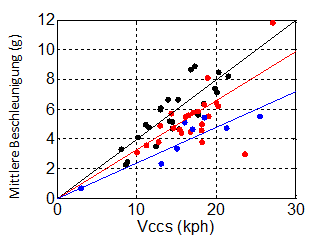More information
Main author
Denis P. Wood
Co-Authors
Colin Glynn, Naoya Nishimura, Ciaran Simms
Type of media
Publication type
Lecture
Publication year
2016
Publisher
25. EVU Congress, Bratislava
Citation
-
 This paper examines the dynamic impact response of cars in full engagement, underride/override and tow ball low speed rear impacts and compares the differences in mean acceleration and dynamic crush as a function of collision velocity and deltaV for the three collision types. The data was derived from detailed analysis of the crash test data in the AGU database. Analysis shows distinct relationships for the three collision types. For any given collision velocity the highest mean accelerations occur in the full engagement impact, with the lowest mean accelerations occurring in the tow ball impacts. It is also shown that the maximum dynamic crush occurs in tow bar collisions, with the minimum dynamic crush occurring in full engagement collisions.
This paper examines the dynamic impact response of cars in full engagement, underride/override and tow ball low speed rear impacts and compares the differences in mean acceleration and dynamic crush as a function of collision velocity and deltaV for the three collision types. The data was derived from detailed analysis of the crash test data in the AGU database. Analysis shows distinct relationships for the three collision types. For any given collision velocity the highest mean accelerations occur in the full engagement impact, with the lowest mean accelerations occurring in the tow ball impacts. It is also shown that the maximum dynamic crush occurs in tow bar collisions, with the minimum dynamic crush occurring in full engagement collisions.
Published research shows that SPUL (Specific Accident Power) more accurately reflects overall injury risk than deltaV (ΔV).The representative SPUL threshold values for the oft-cited 3mph and 5mph deltaV (ΔV) threshold values for the onset of ‘whiplash associated’ injury risk for rear-struck vehicles in the fullengagement case are 20 m2/s3 and 54 2/s3. Equivalent deltaV values which equate to the SPUL threshold values are derived as 3.3mph and 5.5mph for underride/override collisions and 3.8mph and 6.3mph for tow ball collisions.
(EVU-members can download the full article)